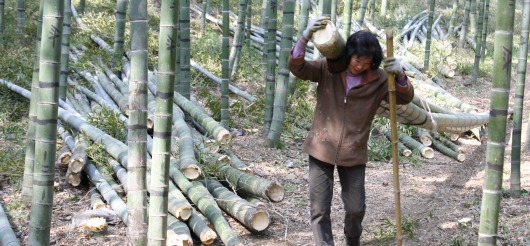Why does gender matter in forestry?
Forests provide monetary and non-monetary benefits to both men and women in forest communities around the world. Men and women often have different roles in managing forests, different knowledge about them, different access to forests and different ways of using forest resources. Forestry tends to be perceived as male dominated although women are heavily involved in forest work such as gathering fuelwood, medicinal plants and other non-timber forests products, collecting food for family consumption as well as for income, and in processing secondary wood products. In fact, women in forest communities can generate more than 50 percent of their income from forests compared to about a third for men.
What challenges do women face in forestry?
Women are disadvantaged by insecure access and property rights to forest, tree and land resources, by discrimination and male bias in service provisions like credit and technology, and by being excluded from policy formulation and decision making at the household, community and national levels. Women realize only a fraction of the benefits and tend to be involved in decision making only when forest and tree resources are already degraded. Moreover, women’s lack of formal education, employment and personal networks inhibits their ability to influence resource allocation or research.
What are the benefits of mainstreaming gender in forestry?
Research shows that mainstreaming gender equality at all levels of the forestry sector has positive effects on many forest management issues including resource sustainability, forest regeneration and conflict management. Properly integrating gender equality issues in forestry development contributes to meeting environmental targets, avoiding adverse impacts on women and contributing to the transformation of unequal gender relations within the forestry sector. Reducing the gender gap in forestry can also help to achieve broader social and economic goals, including the Sustainable Development Goals. Equality between men and women can significantly improve sustainable forest management, the overall welfare and social protection of families, communities and national economies, and it can help to create food secure environments.
As an example, FAO’s community forestry team implemented a woman-focused branch-wood project in The Gambia that produced significant monetary benefits. The project was in an arid region where there were frequent fires. The women collected branches in the most susceptible areas before they could be lost to fire and sold the branch wood in local markets. Because of the women’s contribution to forest fire management and their new income, women were empowered and the gender balance improved.
How can you mainstream gender in forestry?
How can you mainstream gender in forestry?
A recent FAO publication, titled How to mainstream gender in forestry: a practical field guide, can assist FAO forestry officers to develop concrete actions that bring gender issues into the mainstream in forestry projects and programmes.
The actions might involve seeking ways to increase women’s participation in such areas as community forest management groups, small- and medium-scale enterprises, non-governmental organizations and village administration. Measures might also be considered to increase women’s participation in marketing non-wood forest products (NWFP), including food and medicines, to help empower women in the forestry sector.
The guide is compact enough to carry into the field and comes with a helpful table to record data and information gathered from the field. The guide can also help officers in determining when more capacity is needed to better address gender issues in their work.
The field guide provides practical advice such as how to:
- conduct a gender analysis to gauge the particular challenges women face when participating in policy-making, income-generating and community-level activities;
- plan meetings and activities at a time and place that fits with the schedules of women stakeholders, allowing children when possible;
- maintain a dialogue between women’s advocacy groups and the government;
- advocate for a stronger role for women in policy and decision-making; and
- ensure women have leadership and decision-making roles rather than simply counting the number of females at meetings.
Read the guidelines here.
How can the challenges of gender and forestry be removed along the value chain?
How can the challenges of gender and forestry be removed along the value chain?
There is huge potential for engaging women along the forestry value chain. To do so, governments, NGOs and the private sector must intervene by empowering women entrepreneurs, increasing their participation in policy making, encouraging women to join or form and strengthen forestry groups and associations, and acting to link them to markets and industry stakeholders. By engaging in collective action, women would be able to gain a more powerful position in the value chain. This is advantageous in several ways: stronger bargaining power; ensuring a sustainable supply of products; reducing transaction costs; attracting more and larger buyers; accessing outside resources, such as extension and development assistance; accessing the lucrative fair-trade and certified markets; and contributing to the policy formulation process.
What are the key aspects for achieving gender equality in forestry?
What are the key aspects for achieving gender equality in forestry?
To address the current gender gap, the forestry sector must continue to help mainstream gender in forestry policies and must work with programme and project leaders at the country level to address this challenge. Further actions to be taken include collecting greater gender disaggregated data to ascertain the roles of women and men in forestry, disseminating more knowledge and communication products, and increasing the capacity of women and their participation in associations and producer organizations.



